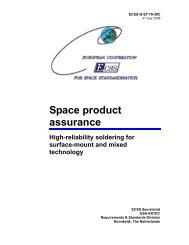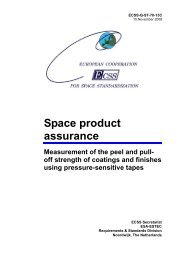ECSS-Q-70-03A (7 April 2006)
ECSS-Q-70-03A (7 April 2006)
ECSS-Q-70-03A (7 April 2006)
Create successful ePaper yourself
Turn your PDF publications into a flip-book with our unique Google optimized e-Paper software.
<strong>ECSS</strong>-Q-<strong>70</strong>-<strong>03A</strong><br />
7 <strong>April</strong> <strong>2006</strong><br />
Principles and prerequisites of black-anodizing<br />
4.1 Principles<br />
4.2 Prerequisites<br />
The black-anodizing of a metal consists of submitting the part to be coated to a<br />
controlled oxidation treatment during which the metallic surface is<br />
transformed into an oxide layer, partly growing in the substrate. Compounds or<br />
dyes are sealed in the oxidized layer, thus providing the required optical or<br />
thermo-optical properties to the surface.<br />
NOTE For space applications, only inorganic dyes are<br />
suitable, as radiation do not strongly impact on<br />
their thermo-optical properties.<br />
4.2.1 General<br />
The adequacy of these treatments shall be demonstrated through a<br />
qualification programme. Depending on the specific project requirements, the<br />
coating applied shall fulfil part or all the acceptance criteria given in Clause 6<br />
of this Standard.<br />
4.2.2 Metal to be black-anodized<br />
a. Not all metals and alloys are suitable for black-anodizing treatment. The<br />
most commonly treated are titanium, aluminium and their alloys. In<br />
particular, the composition of the alloy, the manufacturing process and the<br />
alloy temper can have an impact on the response to the black-anodizing.<br />
b. Aluminium alloys containing a high amount of copper (5%), zinc (6%) or<br />
silicon (5%) are known to respond poorly to some treatments.<br />
c. Wrought alloys are generally easier to treat than cast alloys.<br />
d. The suitability of the alloy with respect to the anodizing process shall be<br />
demonstrated on test pieces having the same specific characteristics as the<br />
workpiece (see 6.2.1).<br />
NOTE Failure occurred with 7xxx and 2xxx alloys with<br />
processes based on sulphuric acid anodizing.<br />
Failures were evidenced by an adhesive tape-test<br />
after thermo-cycling under vacuum.<br />
4.2.3 Potential limitations on parts geometry and structure<br />
a. The manufacturing process of the part to be coated can have an impact on<br />
its response to the black-anodizing process. Also the geometry of the<br />
hardware can limit the possibility to coat the part.<br />
b. To ensure the best result for anodizing parts, the following shall be<br />
applied:<br />
4<br />
15
















